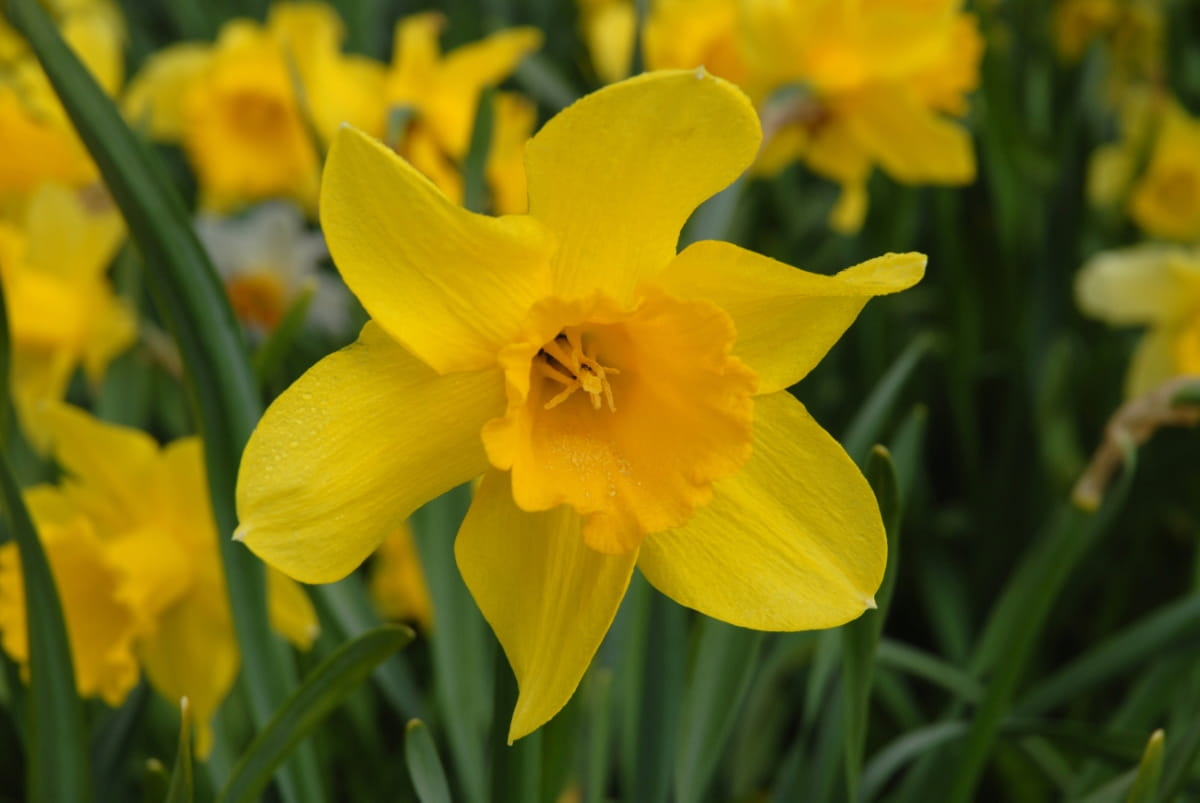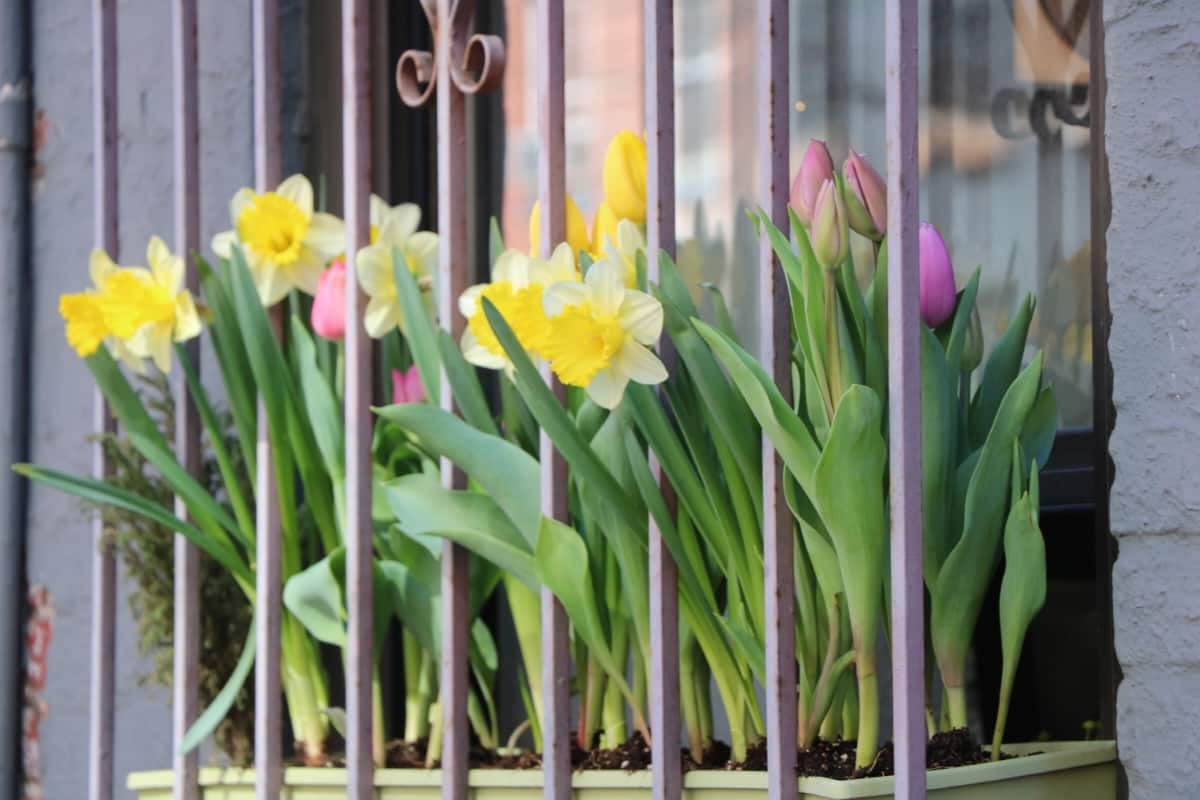Daffodils, with their bright, vibrant colors and delicate structures, symbolize renewal and are one of the first signs of spring. They are beloved flowers and with good reason. This comprehensive guide will provide a step-by-step manual for planting, growing, and caring for daffodils, whether outdoors in your garden or in pots.

How to Grow and Care for Daffodil Flowers
Best Soil and Location for Daffodil Flower Beds
Daffodils thrive in a location with good drainage as they detest waterlogged conditions, which can lead to bulb rot. So, choose a spot in your garden that doesn’t collect standing water. Raised beds or sloped areas often serve as the best locations. Soil-wise, daffodils prefer slightly acidic to neutral pH.
To improve its structure and drainage capacity, you can amend heavy clay soil with organic matter such as compost or well-rotted manure. On the other hand, if your soil is too sandy, organic matter can help increase its ability to hold moisture and nutrients. The soil should be fertile and well-draining, providing a healthy environment for the bulbs to grow. An ideal mix includes a balanced clay, silt, and sand blend.
Sunlight Requirements for Healthy Daffodil Growth
Sunlight plays a crucial role in the healthy growth of daffodils. Optimal growth and blooming of these plants necessitate a minimum of 6 hours of uninterrupted direct sunlight daily. If you plan to grow daffodils indoors, place them near a sunny window with plenty of natural light. Consider planting them outdoors in areas with southern or western exposure for the best flowering results. However, daffodils are quite adaptable and can tolerate a little shade, particularly in hotter climates where afternoon shade can protect them from the scorching sun.
Step-By-Step Guide on Planting Daffodil Bulbs in Pots
Growing daffodils in pots bring elegance to patios, balconies, or indoor spaces. Here’s a beginner-friendly, step-by-step guide on how to go about it. First, choose a pot that is at least twice as deep as the bulb and has drainage holes to avoid waterlogging. Place the daffodil bulbs on the soil with the pointed end facing up. Aim for two to three times their height when considering how deep to plant the bulbs. Water the pot thoroughly after planting, ensuring the soil is well-moistened but not waterlogged. Place the pot in a sunny location and continue to water as the top inch of soil dries out.
Watering Tips for Daffodil Plants: A Complete Care Manual
Both overwatering and underwatering can have detrimental effects. Daffodils require regular watering during their growth and blooming period, which usually spans late winter to early spring. During this time, ensure the soil remains slightly moist but not waterlogged. Once the blooming phase is over and the leaves start yellowing, reduce watering gradually. Eventually, let the soil dry out completely as the daffodils enter dormancy in the late spring and summer. If you’re growing daffodils in pots indoors, monitor the soil moisture levels regularly.
Daffodil Propagation Techniques for Beginners
While daffodils can be propagated from seeds, most home gardeners prefer bulb division because it’s quicker and easier. Bulb division is a method of propagation where you split off the smaller bulbs that form around the mother bulb. The best time for bulb division is during dormancy, in late spring or early summer, after the leaves have died. Carefully dig up the daffodil clumps, separate the bulbs, and replant them immediately. Space the new bulbs at least 6 inches apart to give them room to grow and multiply.
Growing Daffodils from Seed: A Beginner’s Tutorial
Daffodil seeds can be harvested from the seed pods that form after the flowers fade. Harvest the seeds when the pods become brown and open. Promptly sow them in a well-draining potting mixture, as daffodil seeds deteriorate rapidly.
Cover the seeds lightly with soil and position the pot in a sunny area, ensuring the soil remains damp but not saturated. Expect seedlings to sprout within a few weeks. However, bear in mind that daffodils grown from seeds may require up to five years to bloom for the first time.
Protecting Daffodils from Pests and Diseases: Essential Tips
Daffodils are generally hardy and pest-resistant, but they can occasionally be affected by pests like bulb flies, nematodes, or diseases such as bulb rot and fungal infections. The best defense against these threats is to provide the optimal growing conditions for your daffodils.
In case you missed it: How to Grow and Care for Butternut Squash: A Comprehensive Guide for Beginners

If you notice a problem, identify the problem and take appropriate action. For example, bulb flies can be controlled with appropriate insecticides, while fungal diseases require treatment with a fungicide. Always ensure to follow the manufacturer’s instructions when using these products.
Pruning Daffodil Flowers: When and How to Do It
Pruning or deadheading daffodils involves removing the spent flowers to prevent the plant from putting energy into seed production. To do this, simply pinch or cut off the flower head after it fades but leave the stalk and leaves untouched. The leaves manufacture food stored in the bulb for next year’s growth, so letting them die back naturally is crucial. If they’re still green, they’re still feeding the bulb. Once yellow and wilt, usually around late spring or early summer, you can safely trim them back to the ground.
Feeding Daffodil Plants: Nutrients and Fertilizers Explained
The best time to fertilize daffodils is in the autumn when you plant the bulbs and then again in early spring when the first green shoots appear. Use a balanced granular fertilizer or a bulb-specific blend following the manufacturer’s instructions. Remember to water thoroughly after applying fertilizer. This helps the nutrients penetrate the soil to reach the bulb and prevents potential fertilizer burn.
Overwintering Daffodil Bulbs: Expert Advice for Beginners
You might wonder about the best way to overwinter daffodil bulbs in regions with harsh winters. The good news is that daffodils are cold-hardy and typically survive winter on the ground without any issues. If you reside in an area characterized by harsh winters and inadequately drained soil, it would be advisable to excavate the bulbs once the foliage has withered. Subsequently, allow them to desiccate and store them in a cool, arid location until the arrival of spring.
In case you missed it: How to Grow and Care for Sago Palm: A Comprehensive Guide for Beginners

If you’re growing daffodils in pots, it’s important to protect the pots from freezing temperatures, which could kill the bulbs. This can be done by moving the pots indoors or into a garage or shed during the coldest months. Alternatively, you can insulate the pots by wrapping them with burlap or bubble wrap or burying them in the ground.
Conclusion
Whether you grow daffodils in your garden or indoors in pots, they will reward your efforts with their cheerful blossoms. With these tips, even beginner gardeners can experience the joy of seeing these harbingers of spring bloom year after year.
- Feed Your Flock for Less: Top 10 Tips to Save on Chicken Feed
- Ultimate Guide to Ossabaw Island Hog: Breeding, Raising, Diet, and Care
- Hatching Answers: The Top 10 Reasons Your Chickens Aren’t Laying Eggs
- Eggs and Economics: Breaking Down the Cost of Raising Backyard Chickens
- Defend Your Greens: Proven Methods to Keep Iguanas Out of Your Garden
- Ultimate Guide to Cinnamon Queen Chicken: A Comprehensive Guide for Beginners
- Ultimate Guide to California Tan Chicken: Breeding, Raising, Diet, Egg-Production and Care
- Ultimate Guide to Marsh Daisy Chicken: Breeding, Raising, Diet, and Care
- 10 Types of Chicken Farming Businesses You Can Start for Profits